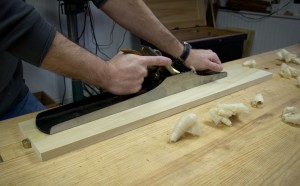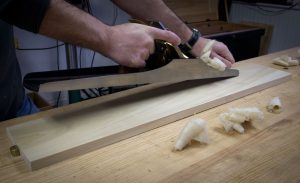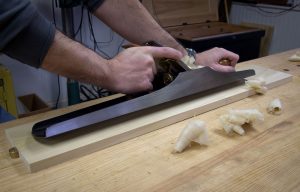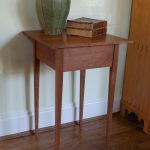We may receive a commission when you use our affiliate links. However, this does not impact our recommendations.
I’m the first to admit that I have some bad habits. I drink beer. I occasionally curse. And I sometimes drag my planes back across my work on the return stroke.
When you receive traditional training, dragging a plane back across your work will get your knuckles rapped by the shop nun. That’s because when you drag the tool back with the sole flat on the work, the wood abrades the tip of the iron, shortening its lifespan.
This is true.
(A quick aside: Allow me to dispel a myth I hear a lot. Here’s the myth: “Dragging the plane back will actually sharpen the iron. Wood is abrasive – like a sharpening stone. So dragging it back actually sharpens the iron.” This is crazy talk. If the wood really did abrade the edge significantly it would be at an angle that would prevent the tool from cutting. It would, in geek speak, create a bevel that would violate the tool’s clearance angle. Anyway, please don’t buy into this load of metric nutjobbery.)
OK, where were we? Ah: This is true.
So why do I drag my planes backward on occasion, becoming a bad example for small children and helpless animals who might be watching? I thought about my bad habit a lot during a seven-hour drive home on Sunday. And here is an explanation of when I drag a plane and why I drag only certain planes.
1. Jack planes: When hogging off material, the last thing I want to do is make the process more tiring. Lifting the plane, even just the heel, tends to slow me down and wear me out a little quicker. The jack doesn’t have to be real keen to do its job, so I don’t worry much about the edge.
2. Jointer planes: I use a No. 8. It’s dang heavy. I’ll lift it on the return stroke when I’m jointing an edge, but when I’m planing a case side or the face of a board, I admit I drag the sucker back. Perhaps I’m lazy or I’ve just developed this bad habit, but I prefer to drag. Why? I don’t have to get the toe of the tool settled as I make the transition from pulling back to pushing forward. The tool is already settled and in full contact with the work. In my mind I can save some time planing, but I might have to sharpen more often as a result.
3. Complex moulders: I drag complex moulders back on the return stroke to ensure they stay in the track I just made with my forward pass. It’s too easy for the moulder to hop out of the profile – so soon you are cutting the ovolo into the fillet, or worse. I don’t like to sharpen these tools, but I also don’t like throwing out sticks of botched moulding into the burn pile. So I drag.
4. Plows and rabbets: I think a fair number of woodworkers drag the planes back when they are using plow planes and rabbet planes. It’s a speed issue. If you lift the tool on the return stroke you will have to find the correct starting point before pushing forward again. Perhaps you can subtly lift the heel back as you pull back and stay engaged in the cut. You might also be a Jedi Knight of Joinery.
OK, here are the tools I almost never (consciously) drag back.
1. Smoothing planes: I hate sharpening and setting up these tools, so I tend to do anything I can to preserve their edges – including lifting the tool or its heel on the return. I am sure there are times (on video) I haven’t lifted the tool. But I prefer not to.
2. Block planes: Ditto all my reasons mentioned with smoothing planes.
3. Hollows and rounds: I sometimes drag these, but usually I don’t. Why? With every pass with these tools, you are usually adjusting their angle in a small or significant way. Plus, they are no fun to sharpen. So I try to lift them on the return stroke.
So there you have it: A short confession and explanation. If you take only one thing away from this blog entry, I hope it is the following sentence: Try not to drag your planes back on the return stroke. It really is the right way to work. But if you are a dragger, just remember that you are not alone.
And stay tuned: Tonight I’ll post what some of the authors of the previous two centuries have to say about this issue. It’s a bit murky.
— Christopher Schwarz
Honestly, I do know something about handplanes. I have a new and well-received DVD called “Super-tune a Handplane,” which shows you how to turn an old plane into a high-performance tool. You can check out that DVD at ShopWoodworking.com here.
Here are some supplies and tools we find essential in our everyday work around the shop. We may receive a commission from sales referred by our links; however, we have carefully selected these products for their usefulness and quality.











This is a great controversy that’s been on my mind and one I question when I teach my students. My thoughts have been that if you drag the plane back you don’t need to re-orient your body and stance for the next stroke. Kind of like you have or get a rhythm going to be efficient. Never having a knuckle rapping nun I thought this made sense!! Interested in any feed back on that one.
It is the harder substance that scratches the softer one, not the other way around. The abrasive effect of wood on steel when dragging the plane should be negligible, and much less than the dulling that results from planing.
To Marty Collins, above: I was at the L-N “hand tool event” at NWS here in Portland. OR last Sat., and was a little surprised to see a demonstrator on their staff (whose name button I did not read) consistently dragging while demonstrating both hogging with a jack and smoothing with a . . . smoother. I’m half deaf, and the sound of the drag back was just like the cut to the front. This just couldn’t have been doing the cutting edge much good, but I’ve learned that demonstrators at L-N events consider themselves the font of all WW wisdom, so I didn’t question him on this point. BTW, I’m also an unapologetic setter of planes on the (wooden) bench straight up. They are much less awkward to pick up again, and I don’t want to leave the edge exposed, as side placement does.
Chris you are ray of sunshine. I’m as guilty as you are for dragging the plane backwards and making contact with the wood. Thank you for the amusing article. I am always looking foreward to your next article. I try very hard not to miss any of the things you have to say. Chris you are a credit to your profession and your hobby. KEEP UP THE GOOD WORK.
Looking foreward to your next witticism. from an avid woodworker, sawdustman in Mich.
My question is does dragging the plane effect the work? My impression is that it does not. If so, then the only reason to lift is to prolong edge life. Maybe worth the effort but probably not. I also shamelessly lay my planes blade-down on the workbench and sometimes “sand” wood…
I work with my stock lying loose on the bench and plane up against stops. If you drag the plane the wood comes with it.
Draggina plane back never thought of it but after thinking about I just release the downward pressure and while on the subject when I am resting and put my plane down I always put on its side. just a thought for a later post.
I saw Toshio Odate at WIA Valley Forge give a talk about… everything. He demonstrated the difference between a hobbyist woodworker and a professional:
– “This is how a hobbyist woodworker planes.” – Puts plane down; pulls plane (remember, he’s using a Japanese plane); stops; lifts up plane; walks back – in a joking/mocking manner – to beginning and starts again. Repeats about five times. Takes about 30 seconds.
– “This is a how a professional does it.” – Puts plane down; moves it back and forth five times in the blink of an eye. Takes about three seconds. “Professional doesn’t have time to lift up the plane.”
Dragging a plane back: Hell, my shoulders are both shot and just to be able to push is wonderful so what is all this fluff about getting ready to push again. Do it like you want to. You will not significantly affect the blade. Instead, be concerned about the outcome of the piece you are working on.
Sounds like time to ask the MythBusters team to find out…
After driving for seven hours thinking about dragging, I’d be willing to bet that planes was not the only thing dragging.
Hello. My name is Marty. And I’m a dragger. But thanks to the help of my woodworking friends and sponsor Thomas Lie-Nielsen I’ve been lifting my planes and maintaining clean and sharp irons for the past six months.
Not a fan of this font change… unless it’s just my browser.
note to self, don’t let your tool drag.
I’ve always been a lifter, never a dragger. I’ve tried the backwards slide, to see if it’s more efficient, but I just can’t keep a rhythm that way; it doesn’t feel right.
It’s a small furry mammal.
What’s a clearance angle? 😉